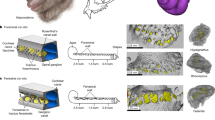Summary
The anatomy of the nasal cavity and the distribution of the olfactory epithelium has been investigated in six neotropical bat species (Phyllostomus discolor, Glossophaga soricina, Carollia perspicillata, Sturnira lilium, Artibeus lituratus, Desmodus rotundus). The five representatives of the Phyllostomatidae show a similary constructed olfactory organ (3 endoturbinals, 2 ectoturbinals), the vampire bat (Desmodontidae) differs markedly in its nasal structures (4 endoturbinals, 2 ectoturbinals). The turbinais are attached in a characteristic matter in both families. All the species investigated have a well developed vomeronasal organ. The nasal anatomy ofMyotis myotis andRhinolopbus ferrum-equinum is discussed in comparison to the neotropical species.
Zusammenfassung
Die Anatomie der Nasenhöhle und die Verteilung des Riechepithels wurden an sechs neotropischen Fledermausarten untersucht (Phyllostomus discolor, Glossophaga soricina, Carollia perspicillata, Sturnira lilium, Artibeus lituratus, Desmodus rotundus). Die fünf Vertreter der Phyllostomatidae besitzen ein ähnlich gestaltetes Riechorgan (3 Endoturbinalia, 2 Ektoturbinalia). Die Vampirfledermaus (Desmodontidae) unterscheidet sich im Bau der Nase deutlich von den Blattnasen (4 Endoturbinalia, 2 Ektoturbinalia). Auch die Anheftung der Muscheln in der Nasenhöhle erfolgt bei beiden Familien in charakteristischer Weise. Alle untersuchten Arten besitzen ein gut ausgebildetes Vomeronasalorgan. Der Nasenaufbau vonMyotis myotis undRhinolophus ferrum-equinum wird unter vergleichenden Aspekten diskutiert.
Similar content being viewed by others
Literatur
Bhatnager, K.P., Kallen, F.C.: Morphology of the nasal cavities and associated structures inArtibeus jamaicensis andMyotis lucifugus. Am. J. Anat.139, 167–190 (1974)
Bhatnagar, K.P., Kallen, F.C.: Quantitative observations on the nasal epithelia and olfactory inner-vation in bats. Acta anat.91, 272–282 (1975)
Eisentraut, M.: Aus dem Leben der Fledermäuse und Flughunde, Jena: VEB Gustav Fischer 1957
Goodwin, G.G., Greenhall, A.M.: A review of the bats of Trinidad and Tobago. Am. Mus. Nat. Hist.122, (New York) (1961)
Grosser, O.: Zur Anatomie der Nase und des Rachens der einheimischen Chiropteren. Morph. Jb.29, 1–77 (1902)
Kolb, A.: Licht- und elektronenmikroskopische Untersuchungen der Nasenhöhle und des Riech-epithels einiger Fledermausarten. Z. Säugetierkunde36, 202–213 (1971)
Kolb, A., Pisker, W.: Über das Riechepithel einiger einheimischer Fledermäuse. Z. Zellforsch.63, 673–681 (1964)
Romeis, B.; Mikroskopische Technik. München: Oldenbourg 1948
Schmidt, U.: Vergleichende Riechschwellenbestimmungen bei neotropischen Chiropteren (Desmodus rotundus, Artibeus lituratus, Phyllostomus discolor). Z. Säugetierkunde40, 269–298 (1975)
Schmidt, U., Greenhall, A.M.: Untersuchungen zur geruchlichen Orientierung der Vampirfledermäuse (Desmodus rotundus). Z. vergl. Physiol.74, 217–226 (1971)
Author information
Authors and Affiliations
Additional information
Herrn Professor Dr. H. Schneider danken wir für die freundliche Unterstützung dieser Arbeit, Herrn Dr. H. Erkert für die Überlassung von Tiermaterial
Rights and permissions
About this article
Cite this article
Kämper, R., Schmidt, U. Die Morphologie der Nasenhöhle bei einigen neotropischen Chiropteren. Zoomorphologie 87, 3–19 (1977). https://doi.org/10.1007/BF02568739
Received:
Issue Date:
DOI: https://doi.org/10.1007/BF02568739




